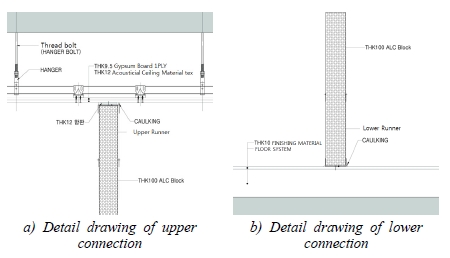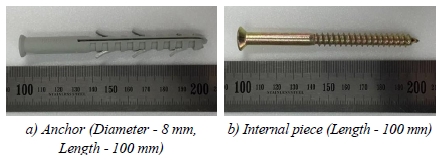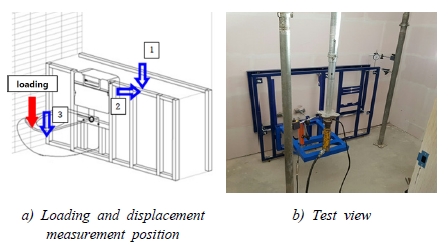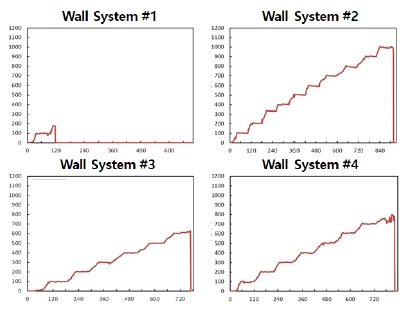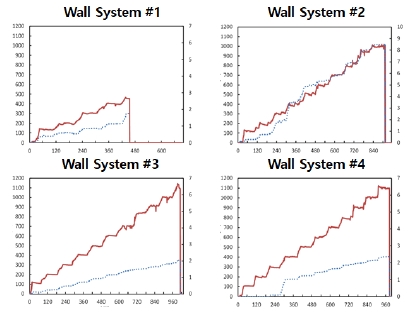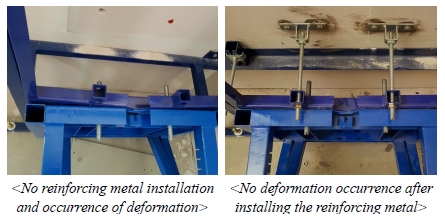
장수명주택 인필 벽체의 부착물에 대한 하중저항성에 대한 연구
ⓒCopyright Korea Institute of Ecological Architecture and Environment
Abstract
Recently, modular buildings, which can flexibly cope with changes due to remodeling and maintenance required for the physical durability of buildings and residential process, are receiving wide attention, and the industrialization house is differentiated from previous houses in such nature. When the residential space is composed of industrialization house, it is possible to compose the space in the form desired by the resident and such space can be modified at a desired period, thus it has greater significance in terms of variability. Therefore, it is necessary to identify problems when the industrialization house is installed on the housing and deduce improvement measures.
This study intends to carry out the improvement priority test for inhibitory factors of lightweight walls in an industrialization housing unit of a modular building, and confirm the performance level through a field test. The building used for the test was a two-story steel skeleton building and the testbed consisting of industrialization houses was established on the first floor for the test. The test result on the wall performance of installed industrialization house was drawn and compared with reference values for the purpose of institutionalization. Test method and evaluation standard were in accordance with ‘Improvement priority evaluation method for wall inhibitory factors (Architectural Institute of Korea).’
The test result showed that the wall system using normal gypsum board was rated as grade 2 for horizontal and vertical pulling, and other wall systems were rated as grade 1. The ALC Block attachment method applied to the toilet system secured wall improvement priority sufficiently. The result of this test is considered to be suitable for presenting directions for future research, and it can be utilized as basic data for summarizing the performance standard of industrialization house of modular building in detail.
Keywords:
Long-life Housing, Infill System, Attachments, Load Resistancy키워드:
장수명주택, 인필시스템, 부착물, 하중저항성1. 서론
1.1. 연구의 배경 및 목적
통계청에 따르면 2014년 우리나라 전체 주택 수는 17,999,283가구이며 그중 8,925,959가구가 아파트로서, 총 주택 수에서 아파트의 비중은 49.6%로 1990년 22.7%에서 크게 증가했다(KOSTAT, 2014). 이러한 아파트의 양적 공급확대와는 별도로 주택 소비자 입장에서는 공동주택에 대한 다양한 요구가 표출되고 있으며, 이에 따른 공동주택의 질적 측면에 대한 관심이 고조되고 있으나 기존 대량공급에 의한 공동주택 획일화 및 소비자 요구 대응한계로 아직 수명이 남아 있는 공동주택이 조기 철거되거나, 재건축 되는 경우가 발생되고 있는 상황이다. 따라서 최근에는 건물의 물리적인 내구성과 거주과정에서 필요한 유지관리 및 리모델링에 따른 변화에 융통성 있게 대응할 수 있는 장수명주택이 부각되고 있다(Kim, Kong & Chu, 2010).
이러한 성질에 있어 기존의 주택들과 차별화되는 것이 인필이며, 주거공간을 인필로 구성할 경우 거주자가 원하는 형태의 공간을 구성할 수 있으며, 원하는 시기에 변경이 가능하므로 가변적인 측면에서 큰 의의가 있다. 그러나 인필에 대한 기준이나 지침 등이 따로 마련되어 있지 않은 상황이기 때문에 주택에 적용했을 시의 예상하지 못한 문제점 등이 발생할 수 있다. 따라서 인필 성능기준의 정립이 필요하며 그 첫 단계로 성능시험을 통해 도출된 결과를 인필성능 기준정립의 기초자료로 활용하고자 한다.
2017년 2월 세종 행복도시에서 착공한 장수명주택 실증단지의 경우, 세대내 벽체가 석고보드 벽체, ALC블록 등의 경량벽체로 시공되며 이에 대한 성능검증이 이루어지지 않아 입주 후 하자 및 문제점이 발생할 수 있다. 따라서 본 연구서에는 인필의 다양한 성능 중 벽체시스템의 부착물에 대한 하중저항성에 대한 성능을 시험을 실시하였으며 결과를 확인하였다.
연구의 방법 및 내용
본 연구에서는 현장실험을 통하여 장수명주택 인필 중 세대내 벽체의 부착물에 대한 하중저항성 시험을 실시하고 그 성능수준을 확인하고자 한다. 실험을 위한 건축물은 2층 철골조 건축물이며, 그 중 실험을 위해 1층에 인필시스템(이중천장, 이중바닥, 벽체시스템)로 구성된 Test Bed를 구축하였으며 설치된 인필 벽체의 성능을 도출한 후 분석하고자 한다. 실험방법 및 평가기준은 ‘벽체 부착물에 대한 하중저항성 평가방법(대한건축학회, 2015)’을 준용하였다.
세종 행복도시의 장수명주택의 거실 및 부엌에는 인필벽체가 사용되며, 벽걸이 TV, 액자 등을 벽체에 설치할 시에 수직당김이 작용하며 콘센트 혹은 벽체에 박힌 못을 뽑을 시에 수평당김이 작용한다. 또한 욕실에는 벽배관 시스템이 적용되어 변기 및 세면대의 하중이 벽체에 작용되므로 이에 대한 물체지지력 시험을 통한 성능검증이 필수적이다.
2.이론적 고찰
2.1. 인필의 개념
「장수명 주택 건설․인증 기준」에 따르면 장수명 주택의 정의는 내구성, 가변성, 수리 용이성에 대하여 성능등급이 만족하는 주택을 의미하며, 서포트(Support)와 인필(Infill)로 구분하고 있다. 서포트의 경우, 공동주택의 공용부분으로 처음 건설한 상태로 100년 동안 유지할 수 있는 고정성이 강한 내구성 확보 및 가변성이 있는 공용설비가 포함되며(Kim, 2004), 인필의 경우 가변성, 수리용이성이 주요한 인자로 작용되므로, 개인의사에 따라 결정되는 내장과 전용설비 등이 해당된다(Hwang, 2003). 일본에서는 장수명주택을 실현하기 위한 일환으로 70년대 후반부터 집합주택을 공적 성격이 강한 부분(서포트)과 사적 성격이 강한 부분(인필)으로 나누어 공급하려는 사상을 실현하려고 하였으며, 90년대 이후 “프리플랜 임대방식”, “쯔구바 방식”등으로 전개 되었다(Lee, 2004). 이러한 측면에서 서포트와 인필을 분리할 경우, 거주자(임차인)가 바뀔 때 마다 서포트는 유지한 채, 가변이 가능한 인필을 통해 공간을 새롭게 구성하는 방식으로 장수명주택을 실현가능하다.
2.2. 인필 벽체에 관한 선행연구
최근 10년 동안 인필에 관한 기존 연구들을 살펴보면 계획 및 특성에 관한 연구가 주를 이룬다. 그러나 인필의 성능에 대한 연구의 수는 적으며, 따라서 본 연구의 실험대상인 건식벽체의 성능관련 연구들은 분석하였고 그 세부적인 내용은 Table1과 같다.
건식벽체의 성능 관련 연구는 차음성(Kim et al., 2013; Yu, 2009 ;Baek et al., 2009)과 단열성(Yu, 2014; Jang et al., 2010) 위주로 진행 되어 왔으며 부착물에 대한 하중저항성(Lee, 2015), 내충격성(Kim, 2015; Roh, 2014)에 대한 연구가 이루어져 ‘경량벽체 설계지침(2015, 대한건축학회)’의 성능평가방법으로 부분 적용되었다. 그러나 실제 주거에 적용되는 벽체를 실험대상으로 한 결과에 대한 연구는 부족한 상황이다.
3.인필 벽체의 부착물에 대한 하중저항성 시험
3.1. 실험개요
본 실험은 현장을 중심으로 진행되어, 바닥면적 18㎡(3,000mm ×6,000mm)에 층고 3,230m의 현장공간에서 차음시험을 수행하였다. 또한 현장실험은 데크플레이트 150mm, 세대내벽 높이 2,400mm로 구성하였다. 실험은 ‘경량벽체 설계지침-벽체 부착물에 대한 하중저항성 평가방법(대한건축학회)’을 준용하여 수평당김 저항성, 수직당김 저항성, 양변기에 대한 하중저항성을 실시하였다.
3.2. 실험체 시공방법
부착물에 대한 하중저항성 시험에 사용된 실험체는 총 4개의 벽체 시스템이며, 수평당김 저항성, 수식당김 저항성 시험을 실시하였다. 시스템 #4(ALC 블록)는 추가적으로 양변기 하중저항성을 실시하였다. 면적 가로 3,000×세로 6,000(mm)의 공간에 인필 천장재와 인필 바닥재를 설치한 후, 가로 3,000×높이 2,400(mm)크기의 인필 벽체를 천장재와 바닥재 사이에 설치하는 방식이다. 이러한 시공방법을 사용한 이유는 실험결과에 영향을 크게 미치지 않을 것으로 판단되나, 장수명주택의 실제 주거환경을 유사하게 구현하기 위함이다. 시스템의 구체적인 내용은 Table 2와 같다.
석고보드 칸막이벽체인 벽체시스템 #1~2는 50T Stud+Runner와 12.5T 석고보드 2PLY로 이루어진 구조이다. 시공 프로세스로는 바탕 청소 후 벽체 위치 확인 및 상․하부 런너를 시공하고, 벽체의 골조를 이루는 Stud를 설치한다. 그 다음으로 석고보드 1면 2PLY 시공, 석고보드 2면 2PLY 시공, 마지막으로 상․하부 실리콘 코킹 충진으로 완료된다. 벽체시스템 #2의 경우 일반 석고보드 대신 차음석고보드로 시공된다.
벽체시스템 #3은 2시간 내화용으로 50T Stud+Runner와 19T 방화석고보드 2PLY로 이루어진 구조체가 이중으로 시공된다. 시공 프로세스는 벽체시스템 #1~2과 유사하며, 다만 석고보드와 석고보드 사이에 50T 글라스울을 삽입하는 차이점이 있다.
벽체시스템 #4는 100T Runner와 100T ALC Block으로 이루어진 구조이다. 시공 프로세스로는 상․하부 런너 및 벽면 런너를 시공하고, 본드 접합에 의한 ALC Block 조적시공, 마지막으로 조인트 코킹 마감으로 완료된다.
천장시스템은 아파트용 M-Bar와 Carrying Channel로 구성된 경량철골천장틀에 9.5T 일반석고보드 1PLY로 시공된다. 시공 프로세스로는 목업 실험장소의 특성상 천장 Slab가 아닌 SQ-Bar에 전산볼트와 함께 행거를 설치하고, 아파트용 M-Bar 설치, Carrying Channel 설치, 마지막으로 9.5T 일반석고보드를 시공하여 완료된다.
바닥시스템은 건식이중바닥 구조로 공장에서 측면완충재를 제외하고는 완성되어 온 시스템 부분자재들을 연결 시공하여 완성된다. 시공 프로세스로는 측면완충재와 바닥마감재를 제외하고는 공장에서 완성되어온 시스템 부분자재들을 조립하여 시공됨으로써 시공이 간편하다. 측면 완충재를 설치하고, 바닥시스템 자재들 조립 설치, 수평을 잡은 후 고정을 위하여 나사못을 시공하여 완료된다.
3.3. 실험조건 및 방법
본 연구의 벽체의 물체지지력 실험은 수평당김 시험과 수직당김 시험, 그리고 양변기에 대한 하중저항성 등 세 가지의 방법으로 진행하였다.
“수평당김 저항성” 이란 거주자가 넘어지거나 이와 유사한 상황 발생 시에 벽체에 고정되어 있는 물체를 잡는 행위를 통해 수평으로 가해지는 힘을 견디는 정도를 측정하는 시험이며, 벽체 부착물에 대한 하중저항성 평가방법에 의거하여 Table 3과 같은 방법으로 실시하였다.
ALC Block 벽체에 대해 적용한 고정용 철물은 Figure 4와 같이 ALC Block 전용 철물을 사용하여 실험을 진행하였다.
“수직당김 저항성”이란 벽체에 걸어 놓는 벽걸이 TV, 액자, 시계 등의 무게를 견디는 정도를 측정하는 시험이며 벽체 부착물에 대한 하중저항성 평가방법에 의거하여 다음과 같은 방법으로 실시하였으며, 수직 당김 시험에 사용한 고정용 철물은 수평 당김시험과 동일하게 시공하였다.
“양변기에 대한 하중저항성”이란 화장실 벽체(경량벽체)에 설치된 양변기 시스템에 대해 양변기 사용에 따라 작용하는 하중에 의한 벽체-양변기의 지지․고정의 안정성을 말하며, 작용하중에 대한 가력을 통해 시스템의 지지․고정을 위해 사용된 고정용 철물-벽체간의 지지력, 벽체 또는 양변기 시스템의 변형 등의 평가를 실시한다.
본 시험은 실제 시공방법에 따라 양변기 시스템을 벽체에 설치하고, 양변기 사용에 대한 하중을 시스템에 직접 가하는 방식으로 평가하였다. 양변기 시스템의 설치 및 구성은 Figure 5와 같고 양변기에 대한 벽체의 하중저항성 시험은 벽체 부착물에 대한 하중저항성 평가방법에 의거하여 다음과 같은 방법으로 실시하였다.
4.실험결과
인필구조인 경량벽체의 구조안전성에 관한 성능기준은 대한건축학회의 「건축용 비내력 경량벽체의 성능 시험방법」을 준용하였으며, Table 6과 같다.
4.1. 수평당김 저항성
각 시험벽체에 대한 수평 당김 시험결과는 Table 7 및 Figure 6과 같다. 벽체시스템 #1의 경우 175N에서 뽑힘 판의 pullout이 발생하였다.
벽체시스템 #2 및 벽체시스템 #3에서는 각각 1,000N, 630N에서 뽑힘 판의 pullout이 나타났으며, 이와 함께 시험틀의 탈락이 발생하는 것으로 나타남. 또한 시험 틀의 탈락 시 하중의 크기에 비례하여 벽체의 손상이 발생하는 것으로 나타났다.
벽체시스템 #4의 경우 775N에서 뽑힘 판의 pullout이 발생하였으며 시험틀의 탈락은 발생하지 않는 것으로 나타났다.
벽체시스템 #1은 수평당김저항성의 기준에 미달이 되었기 때문에 중량물의 설치시 시방서에서 제시되는 철판보강을 하였다. 이 경우 540N에서 뽑힘 판의 pullout이 발생하여 보강에 따른 수평 당김에 대한 하중저항성이 크게 향상되는 것으로 나타났다.
4.2. 수직당김 저항성
각 시험벽체에 대한 수직 당김 시험결과는 Table 8, Figure 7와 같다. 벽체시스템 #1의 경우 455N에서 뽑힘 판의 pullout이 발생하였으며, 2mm 변위는 나타나지 않았다.
벽체시스템 #2는 1,100N에서 뽑힘 판의 pullout과 2mm 변위를 넘어서는 것으로 나타났다. 벽체시스템 #3은 900N에서 뽑힘 판의 pullout이 나타났으며, 이때까지 2mm의 변위는 발생하지 않는 것으로 나타났다. 벽체시스템 #4는 933N에서 2mm 변위를 보였으며, 뽑힘 판의 pullout은 1,100N에서 나타났다.
벽체시스템 #1은 수직당김저항성의 기준에 미달이 되었기 때문에 중량물의 설치 시 시방서에서 제시되는 철판보강을 하였다. 1,000N에서 뽑힘 판의 pullout이 발생하였으나 2mm 변위는 333N에서 나타났다. 이는 시방서에서 제시한 철판보강에 대한 보강방법과 사용된 고정용 철물이 부합하지 않은 것에 기인하는 것으로 판단된다.
4.3. 양변기 하중저항성
본 연구에서는 화장실 벽체(ALC블록)에 설치된 양변기 시스템의 지지․고정에 대한 안정성을 평가하기 위한 시험방법으로 벽체 부착물에 대한 하중저항성 평가방법에 의거하여 실험을 실시하였으며, 이에 대한 결과는 다음 Table 9과 같다.
최대하중 4,000N(400kg)의 적용시 최대 수직(Figure8:a1) 0.22 mm 및 수평(a2) 0.75mm의 변위를 보였으며, 뽑힘판의 탈락 및 시험틀의 탈락, 벽체와의 이격 등은 발생하지 않았다. 따라서 현 양변기 시스템에 적용된 부착방법이 벽체의 하중저항성을 충분히 확보하는 것으로 평가할 수 있다.
또한, 양변기 시험틀의 끝단(a3)에서 측정한 변위는 최대 28mm의 다소 높은 변위가 나타났으나, 이는 벽체-양변기 시스템의 이격․뽑힘이 아닌 양변기 거치부 자체의 변형에 기인하여 발생한 것으로 양변기 거치부와 벽체의 고정을 위한 철물을 보강한 후 시험한 결과, 28mm에서 12mm로 축소되었으며, 이 또한 시험기의 변형에 기인하는 것으로 판단된다.
따라서 이러한 시험 조건을 고려하여 평가하였다. 또한 부착물에 대한 하중저항성에 대한 평가는 제시된 고정용 철물에 의한 결과 값으로 시험체에 대한 절대 값이 아니며, 고정용 철물의 변화에 따라 상이한 성능등급으로 평가될 수 있다.
5. 결론
석고보드 3종(벽체시스템 #1, #2, #3), ALC Block 1종(벽체시스템 #4)으로 구성된 벽체시스템에 대한 부착물에 대한 하중저항성을 평가하기 위하여, ‘경량벽체 설계지침-벽체 부착물에 대한 하중저항성 시험방법’에 규정된 시험방법에 따라 수평 당김 시험, 수직 당김 시험, 양변기에 대한 하중저항성 시험을 실시하였으며 결과는 다음과 같다.
- (1)부착물에 대한 하중저항성 시험방법에 따라 수평 당김 및 수직 당김 시험을 실시한 결과, 일반석고보드를 사용한 벽체시스템 #1은 수평, 수직 당김에 대해 2등급, 차음석고보드(벽체시스템 #2), 방화석고보드(벽체시스템 #3) 및 ALC Block(벽체시스템 #4)을 사용한 벽체시스템은 1등급으로 평가되었다.
- (2)벽체시스템 #1의 경우, 중량물의 설치 시 시방서에서 제시하는 철물 보강을 하였을 경우, 수평당김 시험 시 성능이 크게 향상되어 1등급으로 평가가 가능하다. 그러나 수직당김 시험에서는 pullout기준은 만족하나 변위 2mm가 333N에서 발생한다. 이는 시방서에서 제시한 철판보강에 대한 보강방법과 사용된 고정용 철물이 부합하지 않은 것으로 판단되며 따라서 시방서의 보완이 필요한 것으로 보인다.
- (3)양변기에 대한 벽체의 하중저항성 시험결과, 최대하중 4,000 N(400kg)에서 미소한 수직 및 수평 변위가 나타났으나, 뽑힘판의 탈락 및 시험틀의 탈락, 벽체와의 이격 등은 발생하지 않았다. 따라서 현 양변기 시스템에 적용된 부착방법이 벽체의 하중저항성을 충분히 확보하는 것으로 평가된다.
본 실험에서 진행된 결과는 향후의 연구방향을 제시하기에 적합한 결과로 사료되며, 더 나아가서는 인필 성능기준 및 평가방법을 구축하기 위한 주요한 자료가 될 것으로 판단된다. 또한, 장수명 주택의 인필 성능기준을 구체적으로 정리할 수 있는 기초자료로서 활용이 가능하다.
하지만 인필벽체에 가해지는 물체 지지력은 일방향으로 작용하는 하중이므로 최근에 증가하는 지진 등으로 인해 발생할 수 있는 전도 등으로 인해 발생할 수 있는 복합적인 하중에 대한 연구가 추가적으로 진행되어야 할 것이며 인필 벽체가 하중저항성 등의 안정성을 확보하더라도, 가변성을 만족하지 못할 경우 인필 벽체로서의 의미가 크게 약화될 수밖에 없으므로 가변성, 경제성 등 다양한 요소들이 고려되어야한다.
Acknowledgments
This research was supported by a grant(18RERP–B082173-05) from Residential Environment Research Program funded by Ministry of Land, Infrastructure and Transport of Korean government.
References
-
김경호, 외3인 , 조립형 건식벽체의 차음성능 개선 공법에 관한 연구, 한국소음진동공학회 학술대회논문집, 2013(4), (2013).
Kim, Kyungho, Jeon, JinYong, Kim, SungHoon, Lee, HyungKi, Method of how to improve transmission loss of dry walls, Korean Society for Noise and Vibration Engineering(KSNVE), 2013(4), (2013). -
김기준, 건축용 비내력 경량벽체의 내충격성 시험방법 표준화에 관한 연구, 한서대학교 대학원, 건축학과, 석사학위논문, (2015).
Kim, Ki-Jun, A Study on Standardization of Impact Test Methods of Non-bearing Lightweight Wall for Building Constuction, Hanseo University, Department of Architecture, master's these, (2015). -
김수암, 외3인 , 오픈 하우징의 Support와 Infill 분리에 관한 연구 - KICT 실험주택의 SI분리 수법을 중심으로, 한국주거학회, (2004).
Kim, Su-Am, Lee, Sung-Ok, Lee, Bo-Ra, Hwang, Eun-Kyoung, A Study on the Separation of Support and Infill of KICT Experimental Open Housing - Based on SI separation method of KICT Experimental Housing, Korean Housing Association, (2004). -
김유나, 외2인 , 장수명 주택의 공간구성 분석에 관한 연구, 한국실내디자인학회 논문집, (2010).
Kim, You-Na, Kong, Soon-Ku, Chu, Beom, A Study on Interior Design Planning of Long-Life Housing - Focus on Case Studies, Korean Housing Association, Journal of Korean Institute of Interior Design, (2004). -
노용운, 경량벽체의 내충격성 시험방법에 관한 연구, 한서대학교 대학원, 건축학과, 석사학위논문, (2014).
A study on the Impact-resistance Test Method for Lightweight Wall, Hanseo University, Department of Architecture, master's these, (2014). -
백승경, 외4인 , 건식벽체 차음성능 분석 및 평가, 한국소음진동공학회 학술대회논문집, 2009(11), (2012).
Baek, Seung-Kyung, Chang, Chun-sang, Go, Jong-Cheol, Lee, Jong-In, Kim, Hyun-Bae, Analysis and evaluation of sound reduction performance of drywall system, Korean Society for Noise and Vibration Engineering (KSNVE), 2009(11), (2012). -
오양기, 외4인 , 차음성능을 고려한 친환경 건식벽체 시스템의 다양화 모색, 한국건축친환경설비학회 논문집, 1(3), (2007).
Oh, Yang-Ki, Han, Myung-Ho, Lee, Keun-Woo, Lee, Gyu-Dong, Park, Young-sok, The diversity of Environmentally Sustainable Dry Wall System in view of the Sound Insulation Performance, Korea Institute of Architectural Sustainable Environment and Building Systems, 1(3), (2007). -
유영동, 스틸스터드 건식벽체의 단열성능 추정에 관한 연구, 대한건축학회 논문집 - 계획계, 30(2), (2014).
Yu, Young-Dong, A Study on the Prediction of the Thermal Performance for Steel Stud Framed Wall Systems, Architectural Institute of Korea, 30(2), (2014). [ https://doi.org/10.5659/JAIK_PD.2014.30.2.257 ]
-
유영동, 초고층 아파트 건식벽체의 유형 분류와 차음성능에 관한 연구, 대한건축학회 논문집, 25(5), (2009).
Yu, Young-Dong, A Study on the Survey and Sound Insulation Performance of Drywall System in High-rise Apartment Housings, JARCHITECTURAL INSTITUTE OF KOREA, 25(5), (2009). -
이용규, 일본 SI주택 인필 계획의 현황과 전망, 한국주거학회 학술대회 논문집, (2014).
Lee, Yong-Gyu, Current Status and Prospect of SI Housing Infill System in Japan, Korean Housing Association, (2004). -
이주민, 외4인 , 경량벽체 당김시험의 하중 저항성 평가에 관한 연구, 대한건축학회 학술발표대회 논문집, 33(2), (2013).
Lee, Ju-Min, Kim, Se-Hwan, Kim, Sang-Heon, Choi, Su-Kyoung, Seo, Chee-Ho, The Study on the resistance's evaluation about the pulling test of Lightweight wall, ARCHITECTURAL INSTITUTE OF KOREA, 33(2), (2013). -
이주민, 경량벽체의 부착물에 대한 하중저항성 평가방법 개발에 관한 연구-편심 당김 형태를 중심으로-, 건국대학교 대학원, 건축학과, 석사학위논문, (2015).
Lee, Ju-Min, A Study on Development of The Load Resistancy Test Evaluation Method of Lightweight Wall against Wall Attachments –Based on The Forms of eccentric Pull-, Konkuk University, Department of Architecture, master's these, (2015). -
장철용, 외2인 , 스틸 스터드 변형에 따른 건식벽체의 단열성능 평가, 한국태양에너지학회 학술대회논문집, 2010(4), (2010).
Jang, Cheol-Yong, Kim, Sang-A, Lee, Na-Eun, The Thermal Performance Evaluation of Dry Wall According to Transform of Steel Stud, The Korean Solar Energy Society, 2010(4), (2010). -
황은경, 공동주택의 공간 가변 수용력 향상을 위한 서포트 계획방법 연구, 연세대학교 건축공학과 전공, 박사학위논문, (2003).
Hwang, Eun-Kyoung, Study on the Design Methodology of Support for Improving the Capacity to Change of Multi-family Housing, Yonsei University, Doctoral Thesis, (2003).


